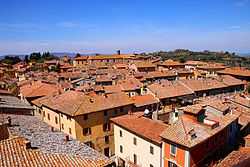Chiusi
| Chiusi | ||
|---|---|---|
| Comune | ||
| Città di Chiusi | ||
 | ||
| ||
 Chiusi | ||
| Coordinates: 43°01′N 11°57′E / 43.017°N 11.950°E | ||
| Country | Italy | |
| Region | Tuscany | |
| Province | Siena (SI) | |
| Frazioni | Chiusi Scalo, Macciano, Montallese, Querce al Pino | |
| Government | ||
| • Mayor | Stefano Scaramelli | |
| Elevation | 398 m (1,306 ft) | |
| Population (31 March 2009) | ||
| • Total | 8,842 | |
| Demonym | Chiusini | |
| Time zone | CET (UTC+1) | |
| • Summer (DST) | CEST (UTC+2) | |
| Postal code | 53043, 53044, 53040 | |
| Dialing code | 0578 | |
| Patron saint | Sta. Mustiola and St. Secondianus | |
| Saint day | 17 June | |
| Website | Official website | |
Chiusi (Etruscan: Clevsin; Umbrian: Camars; Ancient Greek: Klysion, Κλύσιον; Latin: Clusium) is a town and comune in province of Siena, Tuscany, Italy.

History
- For ancient history, see Clusium.
Clusium (in Etruscan) was one of the more powerful cities in the Etruscan League. Chiusi came under the influence of Rome in the 3rd century BC and was involved the Social War.
In 540 AD it was occupied by the Ostrogoths and was later seat of Lombard duchy. From the 11th century it was under the rule of the local bishop, and was later contended by Orvieto and, from 1231, Siena, belonging to the latter until 1556, when it was annexed to the Grand duchy of Tuscany.
Main sights
The lowlands around Chiusi are a treasure trove of tombs for this civilization. The Etruscan Museum of Chiusi is one of the most important repositories of Etruscan remains in Italy.
Other sights include:
- The Romanesque Cathedral (Duomo) of San Secondiano, built around 560 AD over a pre-existing basilica, and renovated in the 13th century. It has a nave and two aisles supported by antique columns. The Sacrament Chapel houses a Nativity and Saints by Bernardino Fugai. It has a separated bell tower which was turned into a defence tower in 1585. Under the tower is a Roman swim pool dating from the 1st century BC.
- The so-called "Labyrinth of Porsenna", a series of tunnels under the town, built in the 6th-5th century BC and probably utilized in Etruscan-Roman times for drainage of rain waters. According to Pliny the Elder (Naturalis historia, XXXVI, XIX, 91-93), the Labyrinth was part of a monument including the sepulchre of the King Porsenna.
Transportation
Chiusi is served by a gate on the A1 Highway. It is also served by a station on the railway connecting Rome to Florence (Chiusi-Chianciano Terme).
Twin towns
 Andrézieux-Bouthéon, France
Andrézieux-Bouthéon, France Neu Isenburg, Germany
Neu Isenburg, Germany
See also
- Lars Porsenna
- Tomb of Lars Porsena
External links
| Wikimedia Commons has media related to Chiusi. |
- Official website
- Harris, W., R. Talbert, T. Elliott, S. Gillies. "Places: 413096 (Clusium)". Pleiades. Retrieved March 7, 2012.
- A blog about Chiusi (in Italian)
-Stemma.png)